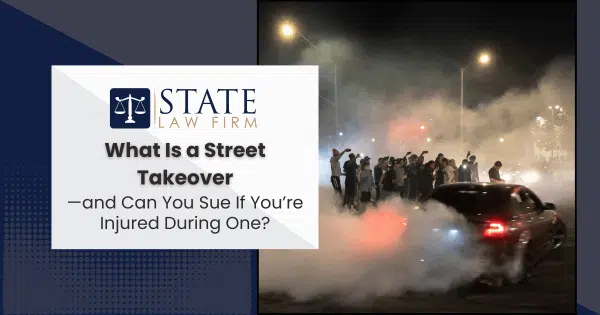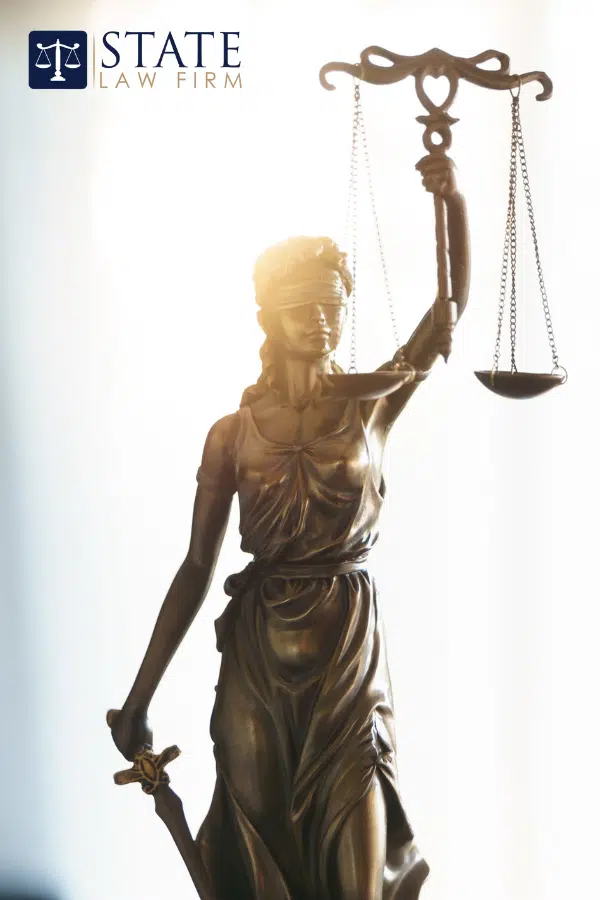Street takeovers are not just a nuisance. They are organized events that shut down intersections or parking lots so drivers can perform stunts, race, and draw large crowds.
If you were hurt as a bystander, pedestrian, or driver during a takeover, California law gives you a path to compensation.
Understanding Street Takeovers in California
In California, a “sideshow” and a “street takeover” are treated the same under state law. The term describes an event where two or more people block or impede traffic on a roadway or in a parking facility to perform vehicle stunts, speed contests, or reckless driving for spectators.
State legislation effective in 2025 expressly links sideshows with street takeovers and expands penalties for exhibitions of speed, including in off-street parking lots. Local governments also continue to pass ordinances to deter organizing and spectating.
Enforcement operations often include vehicle impounds, citations, and coordinated task forces.
For injury victims, the most important takeaway is this: these events are illegal, dangerous, and often well documented by police and media. That combination can produce valuable evidence for a civil injury claim.
Why Street Takeovers Are Dangerous and Who May Be Liable
Street takeovers create layered hazards:
- Drivers perform donuts, burnouts, and racing maneuvers in spaces not engineered for high-speed or stunt driving.
- Crowds stand close to the “pit,” spilling into live traffic lanes.
- Intersections get blocked, delaying emergency response.
- Gunfire, fireworks, and vehicle fires sometimes erupt at larger gatherings.
Depending on the facts, several parties may share legal responsibility for your injuries:
- El conductor whose conduct directly caused the impact or forced evasive maneuvers.
- The vehicle owner who allowed an unfit or unlicensed driver to use the car supports a negligent entrustment theory.
- Organizers and promoters who coordinated the takeover, created the dangerous condition, or encouraged unlawful driving.
- Property owners or managers, if the event took place in a private lot, and they negligently failed to take reasonable steps to prevent predictable harm.
- Public entities, if a dangerous condition of public property contributed to your injury. These claims have special rules and short notice deadlines.
What To Do Right Away If You Are Hurt
Your first steps can make or break the claim:
- Get medical care now. Tell providers you were injured at a street takeover. Follow all treatment plans.
- Call 911 if you can. Ask for a case or incident number. If police respond, request the agency name and report number.
- Capture evidence quickly.
- Photos and video of the scene, vehicles, skid marks, barricades, and the crowd’s position.
- License plates, unique vehicle features, and driver clothing.
- Screenshots or links to social posts advertising the event or boasting after the fact.
- Identify witnesses. Get names, phone numbers, and any footage they captured.
- Preserve your own footage and devices. Do not alter timestamps. Back everything up.
- Do not post about the crash. Insurers and defense counsel scour social media.
- Talk to a lawyer early. An attorney can send preservation letters, request nearby camera footage, and coordinate with investigators.
If the crash involved a hit-and-run or the driver was uninsured, your uninsured or underinsured motorist coverage may apply.
Medical payments coverage can also help with immediate bills regardless of fault. Insurers sometimes cite “racing” or “intentional acts” exclusions to deny claims. A lawyer can analyze your policy and push back where the facts and law support coverage.
How Liability Works and How We Prove Your Claim
California injury law is grounded in a broad duty of ordinary care. From that starting point, several legal theories commonly support recovery in takeover cases:
Negligence and negligence per se. When a driver violates safety statutes that prohibit exhibitions of speed, speed contests, or obstructing traffic to enable stunts, that violation can establish a presumption of negligence if it caused your injury and the law was designed to prevent that type of harm.
We build this out with police reports, body-worn camera footage, and video placing the driver in the “pit” or blocking lanes.
Negligent entrustment. Vehicle owners can be liable if they knew or should have known the driver was unlicensed, intoxicated, inexperienced, or otherwise unfit, yet still allowed use of the vehicle. Jury instructions spell out elements we must prove, such as the owner’s control of the car and knowledge of the risk. We gather DMV records, prior incident history, and communications between the owner and driver.
Premises liability. If a private lot is used, owners and operators owe a duty of reasonable care to keep the premises safe for foreseeable uses. That may include reasonable measures to deter predictable sideshow activity after prior incidents or to promptly address conditions that invite dangerous gatherings. The inquiry is fact-specific. We investigate prior notice, security practices, lighting, barriers, and coordination with law enforcement.
Dangerous condition of public property. If design, signal timing, sight lines, or known takeover patterns at a specific intersection created an unreasonable risk, a public entity claim may apply. These cases require proof of a dangerous condition, causation, foreseeability, and either notice or creation by a public employee. Public-entity claims trigger tight deadlines, discussed below.
Comparative fault and spectators. Defense counsel may argue that a spectator assumed risk by standing near stunts. That does not defeat claims as a matter of law. California uses pure comparative fault, which reduces recovery by your percentage of responsibility rather than eliminating it. Evidence of crowd control, barricades, and your position relative to the pit often counters this defense.
Deadlines You Must Meet
Most California personal injury claims must be filed in court within two years of the injury. Claims against public entities are different. Before you can sue, you must present a government claim within six months of the incident for injuries to a person or personal property. If a public entity denies the claim, you usually have six months from the denial to file suit. Miss these steps and you may lose your rights, though limited late-claim options sometimes exist within one year of the incident.
Because street takeover cases often involve multiple targets and fast-moving investigations, it is smart to start the legal process quickly. We move early to preserve camera footage, request social media takedowns be halted, and gather data from license plate readers when available.
How We Build Your Case
Our team knows how to turn chaotic scenes into clear narratives jurors understand. We:
- Map the scene with measurements, drone imagery when available, and traffic engineering input.
- Authenticate video from phones, nearby businesses, and public agencies.
- Link vehicles and drivers through plate hits, unique modifications, cell records, and posts.
- Trace organization by identifying hosts, promoters, and coordinators who created the danger.
- Quantify losses with medical experts, vocational analysis, and economic projections for wage loss and future care.
Get answers fast in our guide on Car accident lawyers, including deadlines, insurance tactics, and what paperwork matters.
When You Should Call a Lawyer
Call a lawyer as soon as you have stabilized medically. The earlier we are involved, the easier it is to preserve video evidence and identify all responsible parties. We also field insurer calls for you, coordinate benefits, and protect you from recorded statements that can be taken out of context.
The State Law Firm Difference
We are a boutique personal injury firm that treats your case like more than a file number. You get responsive counsel, plain-English explanations, and a litigation plan that fits your goals. If the other side will not pay what is fair, we prepare your case for trial from day one.
Street takeovers are unlawful and dangerous, but injury claims from these events are winnable with the right strategy. Act quickly, get care, preserve evidence, and talk to a lawyer who understands how to prove negligence in a setting that moves fast and leaves debris, data, and digital footprints behind.


